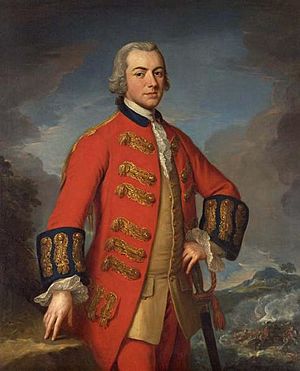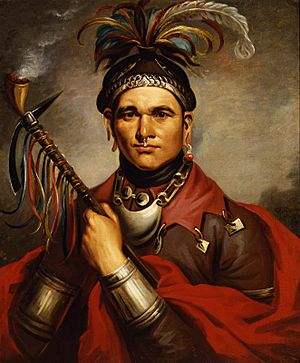List of military leaders in the American Revolutionary War facts for kids
The American Revolutionary War (1775-1783) was a big fight between Great Britain and its 13 American colonies. The colonies wanted to be free and form their own country, the United States. Many brave leaders, both military and civilian, played important roles in this war. This article tells you about some of the most important people who helped shape the outcome.
To be included here, a person had to be:
- A top civilian leader in charge of military matters.
- A high-ranking officer (like a general or admiral) in the army or navy.
- The highest-ranking leader of a country's forces in the war.
- The highest-ranking leader of a state or colonial militia (a local army of citizens).
- A governor who led military actions.
- A Native American tribal leader who directed military actions.
Some people held important jobs in more than one group, like generals who were also in their state's militia.
Contents
United States Leaders

When the war started, American colonists were worried about having a very strong national army. So, each colony usually defended itself with its own local citizen-soldiers, called a militia. Each militia had its own leaders. Some states, like Pennsylvania and Massachusetts, even had their own small navies.
To help coordinate the fighting, the Continental Congress created a regular army, the Continental Army, in June 1775. They chose George Washington to be its commander-in-chief, meaning the main leader. The Continental Army was always growing and changing. Washington often had to use militia troops to help his regular soldiers throughout the war.
Commander-in-Chief
| Name | Role and Experience | Key Contributions | |
|---|---|---|---|
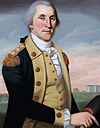 |
George Washington | Served from June 15, 1775, to December 23, 1783. He was a member of the Second Continental Congress and a former Colonel in the French and Indian War. He resigned after the war ended. | George Washington was the top commander of the Continental Army. He reported to the Second Continental Congress. He led the main army, guided the overall war effort for the United States, and managed the entire army. He is known as the "Father of His Country." |
Continental Army Generals
Major Generals
| Name | Role and Experience | Key Contributions | |
|---|---|---|---|
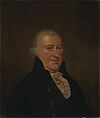 |
Artemas Ward | Served from June 17, 1775, to April 23, 1776. He was the commander of Massachusetts troops. He resigned due to health issues. | He was the first leader of the militia forces outside Boston when the war began. He was the second-highest ranking general after Washington. He helped contain the British at Newport. |
 |
Charles Lee | Served from June 17, 1775, to January 10, 1780. He was a former British Army officer. Congress dismissed him. | An experienced British officer, Lee hoped to be the commander instead of Washington. He was sometimes difficult to work with. He was captured by the British and later dismissed from the army after a court-martial. |
 |
Philip Schuyler | Served from June 19, 1775, to April 19, 1779. He was a member of the Second Continental Congress. He resigned after a disagreement. | As head of the Northern Department, Schuyler planned the 1775 invasion of Quebec. He was active in defending New York in 1777. He also worked with Native American tribes in New York. |
 |
Israel Putnam | Served from June 19, 1775, to June 3, 1783. He was promoted from Colonel of the 3rd Connecticut Regiment. His active service ended in 1779 due to a stroke. | Putnam was active from the start of the revolution. He led forces at the Battle of Bunker Hill. After a stroke in 1779, his military career ended. |
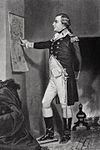 |
Richard Montgomery | Served from December 9, 1775, to December 31, 1775. He was a Brigadier General from June 22, 1775. He was killed in action during the Battle of Quebec. | Montgomery led the invasion of Canada in 1775. He died in the Battle of Quebec, not knowing he had been promoted to major general. |
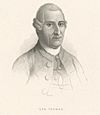 |
John Thomas | Served from March 6, 1776, to June 2, 1776. He was a Brigadier General from June 22, 1775. He died from smallpox during the retreat from Canada. | Thomas was active from the beginning of the war in Boston. He commanded forces besieging Quebec City but died of smallpox during the army's retreat. |
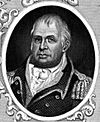 |
William Heath | Served from August 9, 1776, to November 3, 1783. He was a Brigadier General from June 22, 1775. | Heath played a big role in training troops early in the war. He spent most of the war leading the Highland Department. |
 |
Horatio Gates | Served from May 16, 1776, to November 3, 1783. He was a Brigadier General from June 17, 1775. | Gates was in command during the important battle of Saratoga in 1777. Later, his army was badly defeated at Camden in 1780, ending his field leadership. |
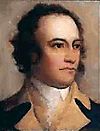 |
John Sullivan | Served from August 9, 1776, to November 30, 1779. He was a Brigadier General from June 22, 1775. He resigned due to poor health. | Sullivan was active from the first days of the war. He served under Washington in New York, New Jersey, and Pennsylvania. He also led an expedition that destroyed Native American villages in New York. |
 |
Nathanael Greene | Served from August 9, 1776, to November 3, 1783. He was a Brigadier General from June 22, 1775. | Greene was one of the best planners in the Continental Army. He served under Washington and later led the successful campaign against the British in the South. He became the army's second-in-command. |
 |
Benedict Arnold | Served from February 17, 1777, to September 25, 1780. He was a Brigadier General from January 10, 1776. He deserted to the enemy. | Arnold was a strong leader early in the war, helping capture Fort Ticonderoga and playing a key role in the Battles of Saratoga. In 1780, he tried to surrender West Point to the British but was caught and joined the British side. |
 |
William Alexander | Served from February 19, 1777, to January 15, 1783. He was a Brigadier General from March 1, 1776. He died in active service. | Alexander spent most of the war with Washington's main army. He was captured at the Battle of Long Island and later exchanged. He fought well in many battles in New Jersey. |
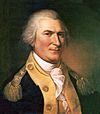 |
Arthur St. Clair | Served from February 19, 1777, to November 3, 1783. He was a Brigadier General from August 9, 1776. | St. Clair led troops in several campaigns. He made the important decision to retreat from Fort Ticonderoga in 1777, which saved his army. He later served as an aide to Washington. |
 |
Benjamin Lincoln | Served from February 19, 1777, to October 29, 1783. He was a Major General of the Massachusetts Militia. | Lincoln was present at three major surrenders during the war. He was forced to surrender his army at Charleston in 1780. He was later present at the Siege of Yorktown, where he accepted Cornwallis's sword. |
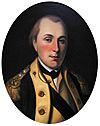 |
Gilbert du Motier, Marquis de Lafayette | Served from July 31, 1777, to November 3, 1783. He was a Captain in the French army. | Lafayette fought with Washington in the Philadelphia campaign and the Battle of Rhode Island. He was a favorite of Washington's, who treated him like a son. |
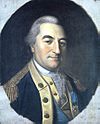 |
Johann de Kalb | Served from September 15, 1777, to August 19, 1780. He was a former Captain in the French army. He died of wounds received in the battle of Camden. | De Kalb served under Washington at Valley Forge. He was sent to the Southern Department and died from wounds in the Battle of Camden. |
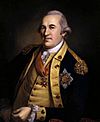 |
Friedrich Wilhelm von Steuben | Served from May 15, 1778, to April 15, 1784. He was a former Captain in the Prussian Infantry. | Steuben's military training and drills at Valley Forge greatly improved the Continental Army's performance. He wrote the United States Army's first training guide. |
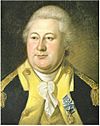 |
Henry Knox | Served from November 15, 1781, to June 20, 1784. He was a Brigadier General from December 27, 1776. | Knox was the chief artillery officer of the Continental Army. He famously brought cannons from Ticonderoga to Boston in 1776. He later became the first United States Secretary of War. |
Brigadier Generals
Here are some other important Brigadier Generals in the Continental Army:
- John Armstrong Sr.
- George Clinton
- John Glover
- Mordecai Gist
- Moses Hazen
- Isaac Huger
- Jedediah Huntington
- William Irvine
- Tadeusz Kościuszko
- Lachlan McIntosh
- William Maxwell
- Hugh Mercer †
- Daniel Morgan
- Francis Nash †
- Enoch Poor
- Kazimierz Pułaski (Casimir Pulaski) †
- Rufus Putnam
- John Stark
- Jethro Sumner
- James Mitchell Varnum
- Anthony Wayne
- George Weedon
- James Wilkinson
- Otho Holland Williams
- William Woodford (died as POW)
- David Wooster † He led the Canadian Department and was killed in the 1777 Battle of Ridgefield.
Militia Leaders
Militia leaders were important for local defense and supporting the Continental Army. Here are a few:
- Connecticut: Gold Selleck Silliman
- Delaware: Caesar Rodney, who signed the Declaration of Independence, led the Delaware militia until 1781.
- Georgia: Samuel Elbert (Major General of the Georgia militia)
- Maryland: Thomas Johnson
- Massachusetts: Joseph Warren †, a doctor who played a key role in Boston's Patriot groups. He helped warn about the British advance on Lexington and Concord and was killed at the Battle of Bunker Hill.
- New Jersey: Philemon Dickinson (Major General of New Jersey Militia from 1777 to 1782)
- New York: Nicholas Herkimer
- North Carolina: Allen Jones (Brigadier General of Halifax District Brigade)
- Pennsylvania: Daniel Brodhead
- South Carolina: Francis Marion, known as "The Swamp Fox," was a Brigadier General who led guerrilla warfare against the British.
- Vermont: Ethan Allen (Major General of the Vermont Republic Militia)
- Virginia: George Rogers Clark, who led Virginia militia on the 1778-79 Illinois campaign.
The Continental Navy was the young United States' naval force.
- John Adams: A famous leader from Boston, he helped create the Navy's rules and commissioned the first warships.
- John Barry: A captain known as one of the "Fathers of the American Navy."
- John Paul Jones: A captain famous for capturing the British ship HMS Serapis during the Battle of Flamborough Head. He is also called a "Father of the American Navy."
- Esek Hopkins: The first commodore and commander-in-chief of the Continental Navy in 1776. He was later relieved of his command.
- Abraham Whipple: A commodore who led one of the first military actions of the revolution, capturing and burning a British ship in 1772.
Great Britain Leaders
The British forces were led by King George III. The main military leader in North America was called the Commander-in-Chief.
British Government Officials
- King George III: The King of Great Britain during the war.
- Frederick North, Lord North: The Prime Minister from 1770 to 1782.
- George Germain: The Secretary of State for the Colonies from 1775 to 1782, in charge of colonial affairs.
Commander-in-Chief, North America
These generals were the top commanders of British forces in North America:
- General Thomas Gage: Commander-in-chief from 1763 to 1775. He was in charge during the rising tensions that led to the war. He was recalled after the Battle of Bunker Hill.
- General William Howe: Replaced Gage and led the war effort in 1776 and 1777. He captured New York City and Philadelphia but failed to control New Jersey. He resigned in 1778.
- Sir Henry Clinton: Commander-in-chief from 1778 to 1782. He oversaw the British retreat from Philadelphia and directed the Siege of Charleston. He also played a role in Benedict Arnold's change of sides.
- Sir Guy Carleton: Governor of Quebec from 1768 to 1777. He defended the province against the 1775 invasion. In 1782, he replaced Clinton and managed the withdrawal of British troops and the relocation of Loyalists.
Other British Generals
- John Burgoyne: A lieutenant general who led a British attempt to control the Hudson River valley in 1777. His army was stopped and surrendered at Saratoga.
- Charles Cornwallis, 1st Marquess Cornwallis: He fought in many campaigns in North America. He was given control of the southern army and was eventually forced to surrender his army at Yorktown, which was the last major battle of the war.
- Richard Howe, 1st Earl Howe: Chief of the North American naval station from 1776 to 1778. He was also given diplomatic power to negotiate peace, but his efforts were unsuccessful.
- William Howe: Before becoming commander-in-chief, he was a main leader of British forces at the Battle of Bunker Hill.
- George Brydges Rodney, 1st Baron Rodney: Commander of the naval station in the West Indies. He famously captured a French admiral in the Battle of the Saintes.
- Francis Smith: A major general who led the expedition to Concord to find rebel weapons. This led to the first battle of the war at Lexington.
Other Notable British Officers
- Major John Andre †: Head of British intelligence. He negotiated with Benedict Arnold and was captured and executed by George Washington.
- Lieutenant Colonel Banastre Tarleton: A cavalry officer who led the British Legion. He was known for his successes on the battlefield.
Royal Governors
- Montfort Browne
- Henry Hamilton
- John Murray, 4th Earl of Dunmore
Frontier Leaders
Native American Leaders
Many Native American leaders from different nations took part in the American Revolution, often siding with the British to protect their lands from American expansion.
- Chickamauga Cherokee: Dragging Canoe
- Lenape: Buckongahelas, Captain Pipe, White Eyes
- Miami: Little Turtle
- Mohawk people: Joseph Brant, John Deseronto, Joseph Louis Cook
- Ojibwe: Matchekewis
- Odawa: Egushawa
- Seneca people: Cornplanter, Guyasuta, Red Jacket
- Shawnee people: Blue Jacket, Black Fish, Cornstalk
- Sioux: Wapasha
- Wyandot people: Dunquat
German Principality Leaders
Great Britain hired soldiers from several German states, often called "Hessians" because many came from Hesse-Kassel.
- Braunschweig-Lüneburg (Brunswick): Major General Friedrich Adolf Riedesel commanded the Brunswick troops. They were surrendered at the end of the Saratoga campaign.
- Hesse-Kassel: Lieutenant General Leopold Philip von Heister was the first leader of the Hessian troops. He was active in the New York campaign.
- Hesse-Kassel: Lieutenant General Wilhelm von Knyphausen replaced von Heister and continued to lead the Hessian forces.
France Leaders
France became an important ally to the United States, providing military and naval support.
French Government Leaders
- King Louis XVI: The King of France, who formally directed France's war effort.
- Charles Gravier, comte de Vergennes: The French foreign minister and a close advisor to the King. He helped bring France and Spain into the war.
French Admirals
- Charles Hector, comte d'Estaing: A vice-admiral active off the North American coast. He participated in engagements in the West Indies.
- François Joseph Paul de Grasse, Comte de Grasse: A rear admiral active in the West Indies. His fleet brought French troops to Virginia and helped trap Cornwallis at Yorktown by blocking the sea.
French Generals
- Jean-Baptiste Donatien de Vimeur, comte de Rochambeau: The commander of French army forces in North America. He led French forces south to participate in the Siege of Yorktown in 1781.
- Charles du Houx de Vioménil: A major general who served as Rochambeau's second in command.
- Gilbert du Motier, Marquis de Lafayette: (Also listed under U.S. Major Generals) A French nobleman who became a major general in the Continental Army and a close friend of Washington.
Spain Leaders
Spain also joined the war against Great Britain, mainly to regain lost territories.
- Bernardo de Gálvez: The governor of Spanish Louisiana and a general. He successfully drove the British military out of West Florida from 1779 to 1781, securing the southern border of the United States.
Dutch Republic Leaders
The Dutch Republic played a smaller military role, but was important economically.
- Johan Zoutman: An admiral in the Dutch Navy. He led the only notable attempt to break a convoy out of Dutch ports, fighting in the Battle of Dogger Bank.
Images for kids


